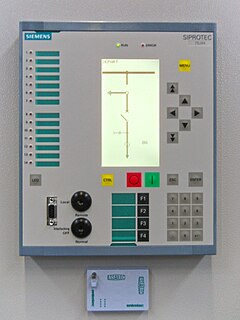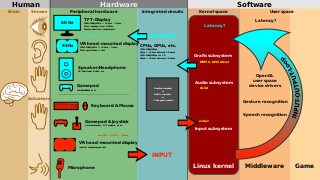
Low-voltage differential signaling, or LVDS, also known as TIA/EIA-644, is a technical standard that specifies electrical characteristics of a differential, serial communications protocol. LVDS operates at low power and can run at very high speeds using inexpensive twisted-pair copper cables. LVDS is a physical layer specification only; many data communication standards and applications use it and add a data link layer as defined in the OSI model on top of it.
A digitally controlled oscillator or DCO is a hybrid digital/analogue electronic oscillator used in synthesizers, microcontrollers, and software-defined radios. The name is analogous with "voltage-controlled oscillator." DCOs were designed to overcome the tuning stability limitations of early VCO designs.

Differential signaling is a method for electrically transmitting information using two complementary signals. The technique sends the same electrical signal as a differential pair of signals, each in its own conductor. The pair of conductors can be wires or traces on a circuit board. The receiving circuit responds to the electrical difference between the two signals, rather than the difference between a single wire and ground. The opposite technique is called single-ended signaling.
Differential pairs are usually found on printed circuit boards, in twisted-pair and ribbon cables, and in connectors.

A voltage regulator module (VRM), sometimes called processor power module (PPM), is a buck converter that provides a microprocessor the appropriate supply voltage, converting +5 V or +12 V to a much lower voltage required by the CPU, allowing processors with different supply voltage to be mounted on the same motherboard.

Current mode logic (CML), or source-coupled logic (SCL), is a differential digital logic family intended to transmit data at speeds between 312.5 Mbit/s and 3.125 Gbit/s across standard printed circuit boards.
The POWER4 is a microprocessor developed by International Business Machines (IBM) that implemented the 64-bit PowerPC and PowerPC AS instruction set architectures. Released in 2001, the POWER4 succeeded the POWER3 and RS64 microprocessors, and was used in RS/6000 and AS/400 computers, ending a separate development of PowerPC microprocessors for the AS/400. The POWER4 was a multicore microprocessor, with two cores on a single die, the first non-embedded microprocessor to do so. POWER4 Chip was first commercially available multiprocessor chip. The original POWER4 had a clock speed of 1.1 and 1.3 GHz, while an enhanced version, the POWER4+, reached a clock speed of 1.9 GHz. The PowerPC 970 is a derivative of the POWER4.

The Western Design Center (WDC) 65C02 microprocessor is an enhanced CMOS version of the popular NMOS-based 8-bit MOS Technology 6502 microprocessor—the CMOS redesign being made by Bill Mensch in 1978. Over various periods of time, the 65C02 has been second-sourced by NCR, GTE, Rockwell, Synertek and Sanyo. The 65C02 has been used in some home computers, as well as in embedded applications, including medical-grade implanted devices.

Parallel SCSI is the earliest of the interface implementations in the SCSI family. SPI is a parallel data bus; There is one set of electrical connections stretching from one end of the SCSI bus to the other. A SCSI device attaches to the bus but does not interrupt it. Both ends of the bus must be terminated.
A power-on reset (PoR) generator is a microcontroller or microprocessor peripheral that generates a reset signal when power is applied to the device. It ensures that the device starts operating in a known state.

An active-pixel sensor (APS) is an image sensor where each picture element ("pixel") has a photodetector and an active amplifier. There are many types of integrated circuit active pixel sensors including the complementary metal–oxide–semiconductor (CMOS) APS used most commonly in cell phone cameras, web cameras, most digital pocket cameras since 2010, in most digital single-lens reflex cameras (DSLRs) and Mirrorless interchangeable-lens cameras (MILCs). Such an image sensor is produced using CMOS technology, and has emerged as an alternative to charge-coupled device (CCD) image sensors.
In integrated circuits, electrical power is distributed to the components of the chip over a network of conductors on the chip. Power network design includes the analysis and design of such networks. As in all engineering, this involves tradeoffs - the network must have adequate performance, be sufficiently reliable, but should not use more resources than required.
Supervisory circuits are electronic circuits that monitor one or more parameters of systems such as power supplies and microprocessors which must be maintained within certain limits,and take appropriate action if a parameter goes out of bounds, creating an unacceptable or dangerous situation.
AT91CAP is a family of Atmel microcontrollers based on the 32-bit RISC microprocessors from ARM. They include a block of metal-programmable logic gates that can be personalized by the application developer. The MP Block can contain one or more additional processor cores, additional peripherals or interfaces, or application-specific logic such as a GPS correlator.

In utility and industrial electric power transmission and distribution systems, a digital protective relay is a computer-based system with software-based protection algorithms for the detection of electrical faults. Such relays are also termed as microprocessor type protective relays. They are functional replacements for electro-mechanical protective relays and may include many protection functions in one unit, as well as providing metering, communication, and self-test functions.
Consumer Ultra-Low Voltage (CULV) is a computing platform developed by Intel. It has been estimated that this market could reach 10 million CULV laptops shipped within 2009. Competing platforms are the VIA Nano, AMD Yukon, AMD Nile notebook platform, and graphic chips from the Nvidia GeForce line within the "Nvidia Ion platform". Some of the lowest power using processors for the ultra thin CULV category may be only a few watts more than the Intel Atom, which is rated at no more than 2.5 W. Because of their low power and heat output, CULV enables very thin computer systems, and long battery life in notebook computers.

In electrical engineering, a protective relay is a relay device designed to trip a circuit breaker when a fault is detected. The first protective relays were electromagnetic devices, relying on coils operating on moving parts to provide detection of abnormal operating conditions such as over-current, over-voltage, reverse power flow, over-frequency, and under-frequency.
The Europe Card Bus is a computer bus developed in 1977 by the company Kontron, mainly for the 8-bit Zilog Z80, Intel 8080 and Intel 8085 microprocessor families.
The Low Voltage Directive (LVD) 2006/95/EC is one of the oldest Single Market Directives adopted by the European Union before the "New" or "Global" Approach. The Directive provides common broad objectives for safety regulations, so that electrical equipment approved by any EU member country will be acceptable for use in all other EU countries. The Low Voltage Directive does not supply any specific technical standards that must be met, instead relying on IEC technical standards to guide designers to produce safe products. Products that conform to the general principles of the Low Voltage Directive and the relevant particular safety standards are marked with the CE marking to indicate compliance and acceptance throughout the EU. Conformance is asserted by the manufacturer based on its conformity assessment.
RX is the family name for a range of 32-bit microcontrollers manufactured by Renesas Electronics. RX is an acronym for Renesas Extreme, a description of the key concept behind the product family, that is "extreme high performance".











